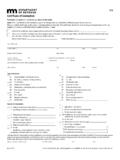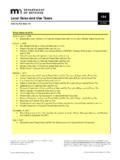Transcription of Municipal Finance Series 2003 8-03 - LOCiS
1 ILLINOIS DEPARTMENT OF COMMERCE AND ECONOMIC OPPORTUNITY. Municipal Finance Series . Office of Local Government Management Services 620 East Adams Springfield, Illinois 62701. Springfield Office: 217/558-2859. 217/558-2860. Printed by Authority of the State of Illinois Introduction The Department of Commerce and Economic Opportunity's Office of Local Government Management Services has published the Municipal Finance Series to assist municipalities throughout the state with the management of their finances and in filing certain reports required by state statute.
2 The Municipal Finance Series is divided into ten sections, each one specializing on a particular subject relating to Municipal Finance . You will find actual working documentation within this publication, which can be extremely useful during various stages of the fiscal year for any municipality. Please review the Municipal Finance Series and use its suggested format to more effectively manage your Municipal revenues and expenditures. Should you need any assistance or have any questions, feel free to contact the Office of Local Government Management Services in Springfield at 217-558-2860 or 217-558-2859.
3 Municipal Finance Series . TABLE OF CONTENTS. SECTION PAGE. 1 Municipal REVENUE SOURCES 1-1. 2 BUDGET REQUEST 2-1. 3 OPERATING BUDGET 3-1. 4 APPROPRIATION ORDINANCE 4-1. 5 TAX LEVY ORDINANCE 5-1. 6 TRUTH IN TAXATION. ALL TAXING DISTRICTS 6-1. 7 MONTHLY REPORTS 7-1. 8 ANNUAL REPORTS 8-1. 9 CHART OF ACCOUNTS 9-1. 10 Municipal BUDGET OFFICER 10-1. Illinois Department of Commerce and Economic Opportunity Office of Local Government Management Services 620 East Adams Street Springfield, Illinois 62701. Springfield Office: 217/558-2860. 217/558-2859. Revised 7/03.
4 Municipal Finance Series . OFFICE OF LOCAL GOVERNMENT MANAGEMENT SERVICES. Municipal REVENUE SOURCES. STATE SHARED REVENUES. 1. SALES TAX. The State distributes 1% of the basic sales tax collected within a municipality to the Municipal government. This tax is imposed on the sale of tangible personal property including food to be consumed off the premises and medicines and medical appliances. The tax rate is higher in Chicago and St. Louis area metropolitan counties for mass transit and in one county (Du Page) for a Water Commission. Home rule municipalities can impose an additional rate without limitation in.
5 25% increments. There are no restrictions in the use of this revenue. Non-home rule municipalities may impose an additional 1/2 of 1% by referendum to be used only for infrastructure improvements. Infrastructure is defined as: streets, bridges, sidewalks, waste disposal systems, water and sewer line extensions, water distribution and purification facilities, storm water drainage and retention facilities and sewage treatment facilities. In addition to the sales taxes returned to the municipalities based upon local sales, municipalities also receive State Use Tax.
6 The Use Tax is distributed on a per capita basis. For the period beginning May 1, 2003 through April 30, 2004, the Illinois Municipal League estimates the per capita distribution to be $ State Use Tax. 2. INCOME TAX. On July 1, 1995, municipalities began receiving one-tenth of the income tax. For the period beginning May 1, 2003 through April 30, 2004, the Illinois Municipal League estimates the per capita distribution to be $ for the Income Tax. There are no restrictions on the use of this revenue. 3. MOTOR FUEL TAX. The State imposes a 19 cent tax on each gallon of gasoline sold at retail.
7 Local governments receive of the collections, after deductions for certain programs and administrative costs. Municipalities receive 49% of local government distributions. The tax revenue is distributed according to population. For the period beginning May 1, 2003 through April 30, 2004, the Illinois Municipal League estimates the per capita Motor Fuel Tax distribution to be $ This revenue is restricted to street related maintenance and improvements and projects must be approved by the Department of Transportation. 1-1. 4. PERSONAL PROPERTY REPLACEMENT TAX.
8 This revenue is derived primarily from the income tax on corporations. It replaces the revenue received from the tax on corporate personal property prior to 1979. Municipalities, exclusive of Cook County municipalities, receive a share of the distribution of these funds based upon the amount of corporate personal property tax collected for them in 1977 in proportion to the total amount of personal property tax collected in the state outside of Cook County. Municipalities in Cook County receive a share of the distribution of the funds based upon the amount of corporate personal property tax collected for them for 1976 in proportion to the total amount collected in Cook County.
9 For the period beginning May 1, 2003 through April 30, 2004, the Illinois Municipal League estimates the statewide distribution to be $700 million. This represents a decrease of over the previous year. Each municipality should also receive from the road district covering the municipality a portion of each personal property replacement tax check issued to the road district, so long as the municipality received a portion of the road and bridge levy in 1979. At the same time, municipalities must return a portion of each personal property replacement tax check to their respective libraries if a library tax was levied on or before December 31, 1978.
10 This revenue is restricted in its use to the retirement of general obligation debt that was incurred on or before December 31, 1978, pension obligations and the Municipal library. When these liens are satisfied, the money can then be used for other purposes related to property taxes. For an explanation of how to calculate the allocation of this money, DCEO has available, upon request, a separate fact sheet on the topic. OTHER SHARED REVENUES. 1. ROAD AND BRIDGE TAX. When a Road District levies a road and bridge tax, one-half of the tax collected on property lying within a municipality, in which streets and alleys are under the care of the municipality, must be turned over to the municipality.



